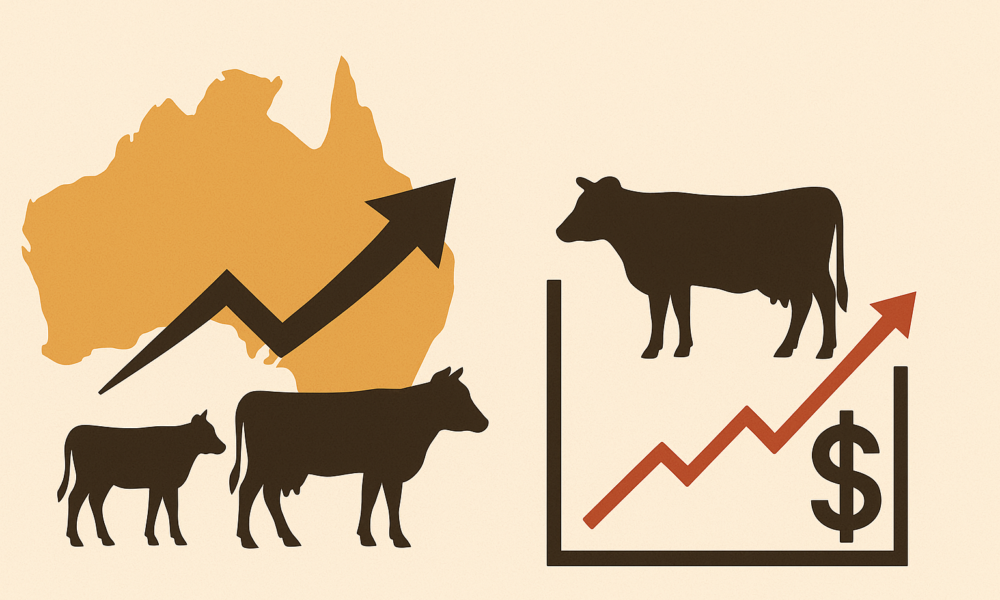Supply Pressures Shift Processor Strategy

Market Morsel
As spring begins, Australia’s cattle market is again recalibrating. While supply indicators are beginning to point toward the earliest stages of a spring flush, the July-to-August period has been defined by tightening southern yardings, an ongoing reliance on northern consignments and a noticeable change in processing behaviour, especially for cows.
Despite a modest improvement in yardings across several key regions, the processor side of the market remains defined by logistical constraints, freight burdens, and patchy workforce capacity.
The most recent data shows national cattle yardings rebounding slightly in August. Queensland lifted from 72 percent to 79 percent of seasonal normal levels, aided by increased saleyard activity in the state’s interior and Darling Downs regions. Western Australia saw the biggest shift, bouncing from just 11 percent in July to 31 percent in August, suggesting early signs of renewed paddock access and buyer interest. South Australia and Tasmania also posted respectable increases, rising from 31 to 40 percent and 51 to 63 percent respectively. However, Victoria and New South Wales moved in the opposite direction. Victorian yardings fell from 58 percent to 51 percent, and New South Wales slipped from 77 to 72 percent. These declines come at a time when processors across the eastern seaboard are already competing for a shrinking pool of quality killable cows.
This divergence in state-level supply coincides with a broader shift in processor utilisation. Through July, Queensland was running at 94 percent of its normal seasonal slaughter pace, but that eased to 79 percent in August. The largest single-week declines in processing activity were also recorded in Queensland saleyards, where rising freight costs, currently hovering between $120 to $150 per head for southern plants sourcing northern stock, have begun to crimp margins. In Tasmania, processor throughput fell dramatically from 59 percent in July to just 29 percent in August. There were also smaller reductions in Victoria, New South Wales and Western Australia, with only South Australia showing a slight increase in processor activity.
These movements reflect a growing caution among southern plants, especially those reliant on transporting cattle from northern regions. Several operators have quietly reduced daily kill shifts or paused Saturday shifts altogether in an effort to balance labour constraints and rising procurement costs. One large southern New South Wales plant has reportedly scaled back to three days of operation per week, a notable change from its more aggressive throughput seen in June. Meanwhile, northern grids continue to attract cattle despite slightly subdued prices, with producers increasingly favouring direct consignment to manage animal condition and limit saleyard exposure.
Against this backdrop, price signals offer a mixed picture. The Heavy Steer Indicator has lifted 18 cents over the past four weeks, now sitting at 428 cents per kilogram live weight. The gain reflects a recovery in demand for quality prime steer lines, especially where feedlot access and proximity to abattoirs reduce handling costs. While not explosive, the lift is meaningful and shows processors are still competing actively for the right type of cattle.
However, it is the processor cow category that tells a more complex story. The Processor Cow Indicator now stands at 372 cents per kilogram live weight, up 12 cents over the past month. While modest on the surface, this increase follows a series of volatile weekly shifts that saw the category briefly spike above 370 cents in early August before easing. The movement underscores the tug-of-war between firm export demand, particularly from US lean beef buyers and tightening domestic supply. Many cows currently offered to market are presenting lighter weights, especially in southern regions, limiting their suitability for manufacturing export programs. Several processors have flagged the declining dressing percentages as a challenge when meeting contracted volumes, prompting greater interest in heavier lines from northern NSW and Queensland.
Yet, even as demand remains solid, the depth of the processor pool is thinning. National weekly kills are struggling to push sustainably beyond 155,000 head per week, held back by structural limitations around labour availability. Despite the appetite to lift kills in anticipation of spring beef promotions and growing US demand, the physical and human resource capacity remains capped. This constraint adds another layer of complexity for processors seeking to manage cost-to-kill against a backdrop of variable supply and slowly rising cattle prices.
While the market has not yet tipped into full-scale competition mode, the signs of tightening are everywhere, especially for cows. Processors are being forced to rethink kill plans, with some shifting their buying zones and others stepping back from overheated grids. It is a familiar late-winter tension, where supply ebbs and logistical pressures mount, and those with flexibility in their procurement approach will be best positioned to navigate what lies ahead.


